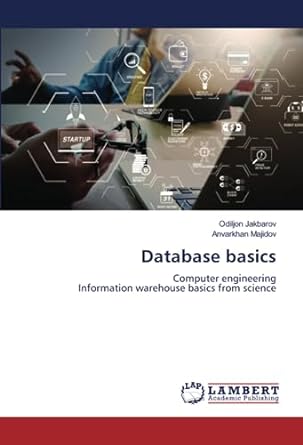Question
Describe the benefits of data warehousing (OLAP) over transactional database systems when building decision support, BI, or historical reporting system. Read the following: Bobs Bell
Describe the benefits of data warehousing (OLAP) over transactional database systems when building decision support, BI, or historical reporting system.
Read the following:
Bobs Bell Bottom and Bait Shop need to produce a reporting system. This decision support system will be used to produce reports used by upper management. Bob has a traditional transactional system thats running very slowly and you recommend a transition to a data warehousing system to support the new reporting system. The I.T. Director of Bobs Bell Bottom and Bait Shop doesnt see the benefits of transitioning to a data warehousing model she just perceives a great capital expense in doing so. She has called a meeting with the companys project manager to provide more context about the necessity of a data warehouse; however, the C.I.O. will be more apt to listen to your recommendations since you are the I.T. consultant she has hired to provide her with additional expertise. You must convince the I.T. Director that data warehousing is the way to go! This will help secure your work with Bobs while helping the company transition to a better and more efficient system for its needs.
Transcript
Chief Information Officer: Welcome aboard! My IT manager has persuaded me to allocate money to build a data warehouse. I dont know much detail about the functionality of a data warehouse and was hoping you, as the project manager, would explain it to me since Ill be shelling out this additional expense.
Project Manager: The basics are pretty simple. Its an operational data store (usually a database) used to hold historical information about your business. Usually, a data warehouse is the source of a business intelligence system (BI) used by your top decision-makers to perform deep historical analysis of your companys data, such as past sales and marketing dollars, then make predictions on things such as future sales based on dependent variables, such as marketing dollars, or sales campaigns
Chief Information Officer: But dont I already have a database?
Project Manager: Yes of course. But its used for different things. The database you have is called a transactional database and holds up to the minute data from your order entry of the customer management system.
Chief Information Officer: So why cant I use the one I have for deep historical analysis?
Project Manager: Its not structured to do so, The transactional database you have is not architected in that way. Plus, if you use this transactional database for analytics AND transactional data, it would cause major performance bottlenecks, among other unpleasant things.
Chief Information Officer: So I need two databases?
Project Manager: For transactional and analytical data yes you should. You may even need more than two databases depending on the level of detail you may require for your business analytics requirements. For example, a subset of a data warehouse called a data mart may be required if you had very subject-oriented data, such as sales figures for a single product line. In that case, you would have a database for your transactional data, a database for your data warehouse, and one for your data mart. So in this case, you would have three.
Chief Information Officer: So a data warehouse does not replace my existing database systems?
Project Manager: Youre getting it. You probably will not have to change your existing database systems at all. A data warehouse runs with your current database. It does not replace them.
Chief Information Officer: Okay, great utilizing a data warehouse will possibly save me the hassle of replacing my existing database systems while providing me with a system to provide much-needed analysis to increase the productivity of my business. Thanks for the explanation! I do, however, want to also see what our I.T. consultant thinks about moving to a data warehouse before I take this leap!
Step by Step Solution
There are 3 Steps involved in it
Step: 1

Get Instant Access to Expert-Tailored Solutions
See step-by-step solutions with expert insights and AI powered tools for academic success
Step: 2

Step: 3

Ace Your Homework with AI
Get the answers you need in no time with our AI-driven, step-by-step assistance
Get Started


